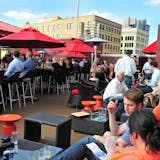In June 2015 — at a time when it seemed small independent bookstores were going the way of buggy whips and VHS tapes — St. Paul's SubText Books made a decision: Not only would it continue as a brick-and-mortar bookstore, but it would move downtown.
SubText previously filled a basement space in the Blair Arcade, beneath Nina's Coffee Cafe. Matt Keliher, the store's manager and book buyer, said SubText was enticed downtown by an attractive sales pitch — and it was time to come up from underground.
While the COVID-19 pandemic siphoned away some of SubText's momentum, Keliher said the bookstore has made the kinds of structural changes that not only have helped it survive, but cater to downtown's growing residential population.
In a recent interview with Eye On St. Paul, Keliher talked about how SubText continues to thrive, serving people drawn to the unique charms of a small, independent bookstore.
This interview was edited for length.
Q: Why did you take the plunge to move downtown in June 2015?
A: Just getting above ground made a huge difference to us. Also, downtown St. Paul felt like it was ripe for an opportunity. It needed a bookstore. John Rupp at the time owned the building and made a pretty compelling pitch [to store owner Sue Zumberge]. And we have absolutely loved it here.
Q: What does SubText offer that people can't find at Amazon? And what is the trick to surviving as a small bookstore?



